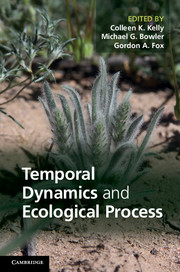Part II - Application to specific questions
Published online by Cambridge University Press: 18 December 2013
Summary
Application to specific questions
The second section of this book looks to addressing specific questions with the analytical tools of temporal processes. Temporal processes take on a wider framework here than in the previous section, including consideration of internally driven fluctuations. The extent to which species aggregated within a landscape are experiencing temporal variation is likely to become an important topic in the future, and we can look forward to fruitful development of these explorations as and when they are challenged by real data from real communities.
Yoh Iwasa and colleagues and Akiko Satake and colleagues provide a tandem approach to masting, the periodic synchrony of reproduction in forest trees. Iwasa et al. first deal with masting within species, after which Satake et al. address multispecies masting. These chapters depend upon elaboration of a very simple biological model for resource reserves, the idea being that if a tree depletes its resources severely in an episode of fruiting it will have no resources to spare for reproduction for several years thereafter. The studies offer a fascinating review of complicated time-dependent phenomena emerging from a model that is very simple, both biologically and mathematically. Although not directly related to the role of environmental fluctuation in promoting coexistence, there is an indirect link: the phenomenon of masting generates a fluctuating environment for seed predators, and fluctuating levels of infestation constitute a fluctuating environment for the species of insect which prey upon the larvae that feed upon the seeds.
- Type
- Chapter
- Information
- Temporal Dynamics and Ecological Process , pp. 189 - 190Publisher: Cambridge University PressPrint publication year: 2014



